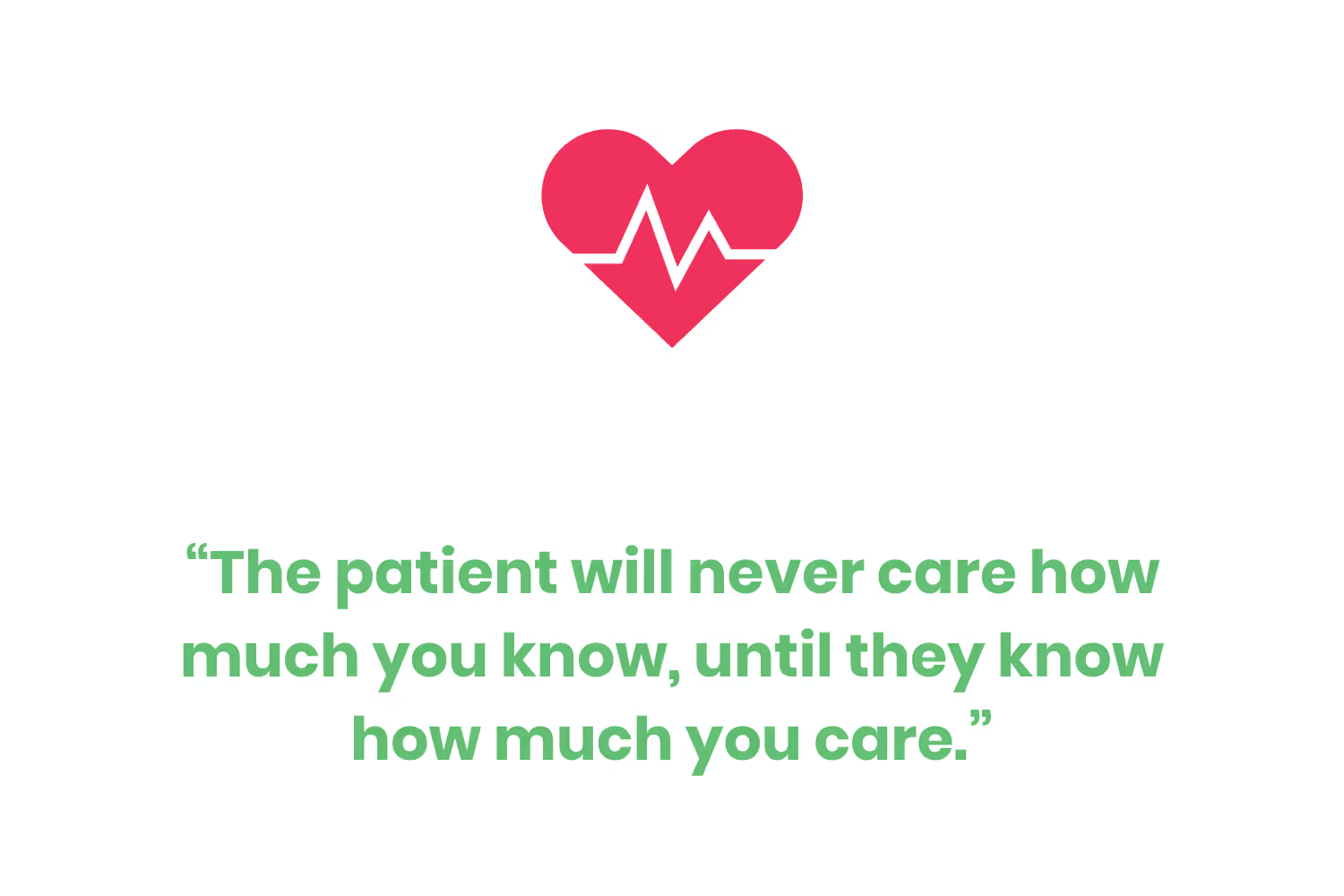Doctor Reputation Management: How to Take and Avoid The L
I’d wager to say that the old saying, “All PR is good PR,” doesn’t work in the healthcare industry. But is there a way to manage your reputation as a doctor? Yes.

If you talk to your average, everyday public relations professional about ways to manage yourself or your practice’s reputation it won’t take long before they reiterate the cliche saying, “All PR is good PR.”
Although that’s a comforting thought, I’d wager to say that that concept doesn’t exist within the healthcare industry. There’s so much more at stake when it comes to working as a doctor or other medical professional that just one bad headline could place the entire organization at risk of existing.
What’s the worst thing that could happen to a doctor that hurts their reputation? There are two that come to my mind right off of the top of my head…
- Malpractice lawsuit
- Large HIPAA breach
Of course, there are other things that could happen throughout your career that could have a negative impact on your reputation (like patients complaining about your services on social media). But, those are the top two worst things you’d have to manage properly or else face massive consequences.
74% of patients say that they would switch their doctor if they found multiple malpractice suits online. Think about that in terms of revenue, do you think your practice could keep its doors open if you lost that many patients? Probably not.
Yet, malpractice suits are almost an inevitability. Modern-day doctors can expect to see a malpractice lawsuit filed against them once every seven years. The average age of retirement for physicians is 65 but they don’t get out of medical school until they’re at least in their mid-to-late twenties. That leaves around 40 years of actual time as a doctor. In other words, you could face almost 6 malpractice lawsuits over the course of your career.
You could argue that malpractice lawsuits must not be that big of a deal if those numbers I just threw at you hold true. That is a valid argument considering only 7% of all of these lawsuits end up going to trial. Yet, do you think taking your chances is a good idea? Just because your malpractice suit settled prior to a court hearing doesn’t mean your patients will overlook it.
So, is there a way to manage your reputation as a doctor? Yes.
Research Yourself Online
As we both know from working within healthcare, nothing productive starts without a good ol’ audit.
Reputation management can’t start without first knowing where you stand in the eyes of the public. But, what exactly should you do?
First, you should Google yourself. I imagine you’ve done it before at some point or another to see what the world’s most popular search engine comes up with. However, you probably only looked up your first and last name. That isn’t helpful if you’re trying to figure out your reputation as a doctor.
You’re a unique person, serving the community in a prestigious position, but you didn’t get to choose your name. In other words, there could be millions of people, in the US alone, with the same name as you if it’s common.

I conducted a quick search on a website called How Many of Me to see the results of the most common name I could think of, John Smith. According to that site, there are almost 5.5 million Americans with the name John Smith.
Thus, Googling just your first name and last name isn’t going to work to find out your reputation as a doctor. You have to add your prefix or title as well. Once you’ve done that, you’ll be able to see if there’s any negative press about you. Hopefully, articles from local news stations about an unintentional HIPAA breach from your practice don’t show up within the results.
Second, check out the websites you encourage your patients to write positive reviews about their experience with you. Not every patient you ask to rate you positively will do so. Either way, these websites are the most accurate place to get a gauge on your reputation.
Third, search the social web. No matter what specialty of healthcare you serve, there’s a high chance that your patients are active across social media. The searching capabilities of these platforms are surprisingly impressive. Thus, search the name of your practice and/or yourself to see if anything comes up.
After doing these three steps, you’ve concluded your preliminary reputation management research. It’s now time for the action phases.
Once It's Out There, You Can't Delete it
The most important aspect to understand when it comes to managing your reputation is that once it’s published on the web, you can’t delete it.
It would be nice if you could delete everything that online users have ever said about you. Yet, that’s not how the internet works.
The reality is that someone had a bad experience with you, went home and wrote some nasty things about your professional output. Worse, they accuse you of malpractice. You can’t change what happened in the past or the fact that what someone posted about you exists.
What can you do?
Well, one of your best options might be to face negative publicity head-on. Every review platform offers the ability for the organization to reply to what people write about it and doing so has benefits.
When a practice addresses negative feedback, their client’s satisfaction almost doubles.
Of course, responding to angry reviews is an art that requires mastering within itself. As the saying goes, you don’t want to pour gas over a fire and make things worse. In other words, you should be very careful with what you say in your response.
You don’t want to respond with your emotions. If you do, you may make the same mistake other healthcare organizations have made in the past and respond with compromising information. That would have the exact opposite effect of what you’re trying to accomplish.
Not every negative comment needs your response, though. In fact, almost 40% of every review is fake. These could either be from a bot or someone with too much time on their hands to troll your page.

As an example, the Taj Mahal has a 4.6 star Google Review rating. If anything deserves a 5/5 star rating I think one of the seven original wonders of the world should, but I digress. The two reviews in the image above are two of many 1-star reviews. Both of them are vague, incorrect sentences that don’t fit with the “service” the Taj Mahal offers.
I blurred out the names of both of the Google users who wrote the reviews just to be safe, but the chances of these being fake are high.
If this scenario happens to you while you’re trying to manage your reputation, you could either answer them with a question for specifics or ignore them entirely. Most likely, future and existing clients that place a high value on reviews will be able to distinguish the real ones from the fakes.
Meet The Negative with Positive
During the introduction of this blog post, I listed two of the biggest impacts on your reputation as a doctor but only went into details about one of them; malpractice lawsuits.
I did this on purpose to leave HIPAA breaches for this section. There’s a difference between how you should react to a malpractice lawsuit and a compliance violation. Although both of them could grab the attention of the media, they require different reputation management approaches.
There’s a high chance that you’ve seen or heard news stories about massive data breaches that lead to exposing thousands or millions of user’s personal information. Outside of the number of those affected by the breach and how it happened, what the organization does in response is most important.
A lot of the time, what organizations that fall victim to a breach do to help their affected customer-base is provide them with some sort of annual identity protection service.

In October of 2020, Hattiesburg, Mississippi based emergency response organization, AAA Ambulance Service, Inc. stated that there was an attempted ransomware attack on their data systems in July. But following an investigation, they discovered in August that the attacker may have viewed or stolen some patient data.
The company said it wasn’t aware of any misusing of its information, and its employees contacted any potentially impacted customers. These customers are being offered complimentary credit card monitoring services.
The last part of that example is what’s most important. After you’ve acknowledged your organization’s misgivings by facing it head-on, try to figure out a way to help any number of clients that whatever happened might have affected. Sometimes it’s less about what you’re giving them and more about the gesture of trying to extend your arm and help.
Bury Bad Headlines with Good Updates
Have you ever seen a celebrity make a comeback after having a meltdown? One year prior they hit rock bottom and everyone gave their opinion about what happened. Hopefully, no one snooped in their medical file if they had to check into the hospital during it.
Nevertheless, out of nowhere, the celebrity comes out of hiding, stars in the next blockbuster movie and gets plastered across every billboard across the country.
This is possible because of three reasons…
- People forget 90% after one month
- The adage, “Americans love a good comeback.”
- Professional PR organizations
I don’t want to break it to you, but you’re not a celebrity. At least, not on a national or global scale. But, that doesn’t mean you can’t also use those three reasons to your advantage. The best part is you won’t have to spend thousands of dollars for a PR organization to help you.

All you have to do is create enough good content that it effectively buries the bad publicity.
This can happen in multiple different ways, some of which relate to topics I’ve touched on in earlier sections. In a nutshell, use the following outlets to produce your own positive news...
- Blog
- Social media posts
- Encourage good reviews
- Video testimonials
If you’re using these consistently, you’re changing the narrative about what happens when users Google your name. Each of these outliers provide you the most control over what the majority of people will see about you. After all, 75% of search engine users stick to the first page of results.
Make Yourself Accessible and Approachable
Certain patients you won’t lose, regardless of whether or not you’re losing some of your reputation. Of course, I’m talking about those who haven’t switched doctors in decades and are your most loyal clients.
However, that doesn’t mean that they aren’t going to ask you about it for clarification. This could happen either electronically or in-person, it varies across clients.
One thing remains true, though, you cannot get defensive or snap at them over asking the question. There are certain things you won’t be able to them, of course, especially if you’re dealing with a malpractice lawsuit.

But, patients want to know what’s going on in order to protect themselves and make sure that they’re still getting the best care available.
One of my favorite quotes about the importance of patient communication comes from a study from 2010, “The patient will never care how much you know, until they know how much you care.”
As a result, you’ll have to field their questions regarding any bad publicity you receive.
This section is very similar to the first one within this blog, you have to face any problems you’re experiencing head-on. Any other alternative won’t end well and could result in losing more of your clients.
Implement a Strategy for Future Bad Press
When you think of some of the largest corporations in the world, what comes to mind?
If you’re a skeptic like me, your thoughts aren’t necessarily positive. Instead, you’re thinking more along the lines of how there’s a high chance that certain aspects of their business aren’t legal. They’re a ticking time bomb of bad PR.
We’ve all heard some of these stories before, like when the Tide POD challenge happened.
Yet, even when these corporations face some of their greatest adversities, they continue to thrive well beyond the bad publicity. The majority of consumers still view Tide as a quality laundry detergent.
How do they pull this off?
The Tide POD challenge wasn’t Procter & Gamble’s first rodeo. The organization has had to face adversity through a public lens before and they probably will have to again at some point in the future.

Yes, these massive corporations have entire departments devoted to “putting out fires” in order to keep their brand image strong. Although it would be nice if you could hire a massive PR firm or team, that’s not feasible.
What is doable, though, is the ability to establish a series of processes and controls before bad PR happens. Think of reputation management similar to what you have to do in order to maintain a compliance environment. Instead of establishing a set of controls that ensures continuity of business after a breach, you’re creating processes that attempt to keep your reputation.
That way, if bad PR comes your way, you’ll be able to spring into action immediately.
Conclusion
As a doctor, part of your job involves managing your reputation (as if you didn’t already have enough on your plate). But, you’re already familiar with establishing the preparations for a bad PR incident because they’re similar to the compliance controls you’ve already put in place.
They’re so similar, in fact, that you could mesh them together into one plan. After all, I did mention that one of the biggest impacts on your reputation as a doctor involves compliance in the introduction to this blog.
Either way, it’s important to keep your reputation in a top frame of mind because they’re essentially an inevitability. However, you’re ready to take on the challenge should it present itself because of the concepts you’ve gone through in reading this blog post.
Emphasize your product's unique features or benefits to differentiate it from competitors
In nec dictum adipiscing pharetra enim etiam scelerisque dolor purus ipsum egestas cursus vulputate arcu egestas ut eu sed mollis consectetur mattis pharetra curabitur et maecenas in mattis fames consectetur ipsum quis risus mauris aliquam ornare nisl purus at ipsum nulla accumsan consectetur vestibulum suspendisse aliquam condimentum scelerisque lacinia pellentesque vestibulum condimentum turpis ligula pharetra dictum sapien facilisis sapien at sagittis et cursus congue.
- Pharetra curabitur et maecenas in mattis fames consectetur ipsum quis risus.
- Justo urna nisi auctor consequat consectetur dolor lectus blandit.
- Eget egestas volutpat lacinia vestibulum vitae mattis hendrerit.
- Ornare elit odio tellus orci bibendum dictum id sem congue enim amet diam.
Incorporate statistics or specific numbers to highlight the effectiveness or popularity of your offering
Convallis pellentesque ullamcorper sapien sed tristique fermentum proin amet quam tincidunt feugiat vitae neque quisque odio ut pellentesque ac mauris eget lectus. Pretium arcu turpis lacus sapien sit at eu sapien duis magna nunc nibh nam non ut nibh ultrices ultrices elementum egestas enim nisl sed cursus pellentesque sit dignissim enim euismod sit et convallis sed pelis viverra quam at nisl sit pharetra enim nisl nec vestibulum posuere in volutpat sed blandit neque risus.

Use time-sensitive language to encourage immediate action, such as "Limited Time Offer
Feugiat vitae neque quisque odio ut pellentesque ac mauris eget lectus. Pretium arcu turpis lacus sapien sit at eu sapien duis magna nunc nibh nam non ut nibh ultrices ultrices elementum egestas enim nisl sed cursus pellentesque sit dignissim enim euismod sit et convallis sed pelis viverra quam at nisl sit pharetra enim nisl nec vestibulum posuere in volutpat sed blandit neque risus.
- Pharetra curabitur et maecenas in mattis fames consectetur ipsum quis risus.
- Justo urna nisi auctor consequat consectetur dolor lectus blandit.
- Eget egestas volutpat lacinia vestibulum vitae mattis hendrerit.
- Ornare elit odio tellus orci bibendum dictum id sem congue enim amet diam.
Address customer pain points directly by showing how your product solves their problems
Feugiat vitae neque quisque odio ut pellentesque ac mauris eget lectus. Pretium arcu turpis lacus sapien sit at eu sapien duis magna nunc nibh nam non ut nibh ultrices ultrices elementum egestas enim nisl sed cursus pellentesque sit dignissim enim euismod sit et convallis sed pelis viverra quam at nisl sit pharetra enim nisl nec vestibulum posuere in volutpat sed blandit neque risus.
Vel etiam vel amet aenean eget in habitasse nunc duis tellus sem turpis risus aliquam ac volutpat tellus eu faucibus ullamcorper.
Tailor titles to your ideal customer segment using phrases like "Designed for Busy Professionals
Sed pretium id nibh id sit felis vitae volutpat volutpat adipiscing at sodales neque lectus mi phasellus commodo at elit suspendisse ornare faucibus lectus purus viverra in nec aliquet commodo et sed sed nisi tempor mi pellentesque arcu viverra pretium duis enim vulputate dignissim etiam ultrices vitae neque urna proin nibh diam turpis augue lacus.


.avif)

